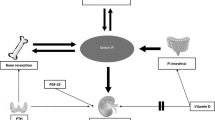Abstract
Long-term use of hydrochlorothizide (HCTZ), a common diuretic agent for hypertension, has been associated with increased bone density and reduced hip fracture rates in patients. In this study, we sought to examine whether HCTZ has an anabolic effect on the proliferation of human osteoblasts (derived from either vertebrate or rib bone samples) in vitro. Cell proliferation was determined by [3H]thymidine incorporation and cell number counting. In medium supplemented with 1% bovine calf serum, HCTZ significantly and reproducibly increased [3H]thymidine incorporation and cell number. The stimulatory effect was dose dependent in a biphasic manner, with the maximal stimulation (approximately 60% above control, P<0.001) seen at 1 μM HCTZ. In fresh serum-free medium, HCTZ was ineffective as a bone cell mitogen, indicating that the bone cell mitogenic activity of HCTZ required a serum growth factor (GF). HCTZ at doses greater than 10 μM was inhibitory in the presence or the absence of serum, presumably because of the cytotoxic effects. The serum requirement for the bone cell mitogenic activity of HCTZ could be replaced with a conditioned medium (conditioned with normal human osteoblasts for 24 hours), or with a mitogenic dose (1 ng/ml) of PDGF. The GF requirement was specific for PDGF, because other bone cell-derived growth factors (i.e., TGFβ, IGF-I, IGF-II, and bFGF) were unable to replace serum for the bone cell mitogenic activity of HCTZ. In summary, this study shows that (1) HCTZ stimulated the proliferation of normal, untrasformed, human osteoblasts in vitro; (2) the bone cell mitogenic effect of HCTZ required the presence of a serum GF; (3) the serum requirement could be replaced with a bone cell GF in conditioned medium; (4) the GF requirement was specific for PDGF. In conclusion, we have demonstrated for the first time that HCTZ has a direct anabolic effect on human osteoblasts in vitro, and that the mitogenic activity is dependent on the presence of PDGF. Because increased bone cell proliferation is a key determinant of bone formation, these observations raise the interesting possibility that HCTZ could act directly on bone cells to stimulate bone formation in patients.
Similar content being viewed by others
References
Wasnich RD, Benfante RJ, Yano K, Heibrun L, Vogel JM (1983) Thiazide effect on the mineral content of bone. N Engl J Med 309:344–347
Adland-Davenport P, McKenzie MW, Notelovitz M, McKenzie LC, Pendergast JF (1985) Thiazide diuretics and bone mineral content in postmenopausal women. Am J Obstet Gynecol 152:630–634
Dawson-Hughes B, Harris S (1993) Thiazides and seasonal bone changes in healthy postmenopausal women. Bone Miner 21:41–51
Ray WA, Downey W, Griffin MR, Melton LJ III (1989) Long-term use of thiazide diuretics and risk of hip fracture. Lancet (I):687–690
LaCroix AZ, Wienphal J, White LR, Wallace RB, Scherr PA, George LK, Cornoni-Huntley J, Ostfeld AM (1990) Thiazide diuretic agents and the incidence of hip fracture. N Engl J Med 322:286–290
Felson DT, Sloutskis D, Anderson JJ, Anthony JM, Kiel DP (1991) Thiazide diuretics and the risk of hip fracture. Results from the Framingham study. JAMA 265:370–373
Lamberg B-A, Kuhlback B (1959) Effect of chlorothiazide and hydrochlorothiazide on the excretion of calcium in urine. Scand J Clin Lab Invest 11:351–357
Middler S, Pak CY, Murad F, Bartter FC (1973) Thiazide diuretics and calcium metabolism. Metabolism 22:139–146
Stot RM, Smith LH, Wilson DM, Dube WJ, Goldsmith RS, Arnaud CD (1972) Hydrochlorothiazide effects on serum calcium and immunoreactive parathyroid hormone concentrations. Ann Intern Med 77:587–591
Steiniche T, Mosekilde L, Christensen MS, Melsen F (1989) Histomorphometric analysis of bone in idiopathic hypercalciuria before and after treatment with thiazide. Acta Pathol Microbiol Immunol Scand 97:302–308
Lemann J, Gray RW, Maierhofer WJ, Cheung HS (1985) Hydrochlorothiazide inhibits bone resorption in men despite experimentally elevated serum 1,25-dihydroxyvitamin D concentrations. Kidney Int 28:951–958
Broulik PD, Pacovsky V (1991) Hydrochlorothiazide inhibits parathormone-stimulated increase in plasma tartrate-resistant acid phosphatase in mice. Calcif Tissue Int 49:51–52
Minkin C (1982) Bone acid phosphatase: tartrate-resistant acid phosphatase as a marker of osteoclast function. Calcif Tissue Int 34:285–290
Hall TJ, Schaueblin M (1994) Hydrochlorothiazide inhibits osteoclastic bone resorption in vitro. Calcif Tissue Int 55:266–268
Hadrava V, Kruppa U, Russo RC, Lacourciere Y, Tremblay J, Hamet P (1991) Vascular smooth muscle cell proliferation and its therapeutic modulation in hypertension. Am Heart J 122: 1198–1203
Mikhail N, Fukuda N, Tremblay J, Hamet P (1993) Platelets, growth factors, and vascular smooth-muscle cells in hypertension and diabetes. J Cardiovasc Pharmacol 22 (suppl 6):S64-S74
Wergedal JE, Baylink DJ (1984) Characterization of cell isolated and cultured from human bone. Proc Soc Exp Biol Med 176:27–31
Wergedal JE, Mohan S, Taylor AK, Baylink DJ (1986) Human skeletal growth factor is produced by human osteoblast-like cells in culture. Biochim Biophys Acta 889:163–170
Wergedal JE, Lau K-HW, Baylink DJ (1988) Fluoride and bovine bone extract influence cell proliferation and phosphatase activities in human bone cell culture. Clin Orthop 233: 274–282
Gospodarowicz D, Bialecki H, Greenburg G (1978) Purification of the fibroblast growth factor activity from bovine brain. J Biol Chem 253:3736–3741
Lau K-HW, Lee MY, Linkhart TA, Mohan S, Vermeiden J, Liu CC, Baylink DJ (1985) A mouse tumor-derived osteolytic factor stimulates bone resorption by a mechanism involving local prostaglandins production in bone. Biochim Biophys Acta 840:56–68
Mohan S, Baylink D (1990) Autocrine and paracrine aspects of bone metabolism. Growth Gen Horm 6:1–9
Wergedal JE, Mohan S, Taylor AK, Baylink DJ (1986) Human skeletal growth factor is produced by human osteoblast-like cells in culture. Biochim Biophys Acta 889:163–170
Weiner IM, Mudge GH (1985) Diuretics and other agents employed in the mobilization of edema fluid. In: Gilman AG, Goodman LS, Rall TW, Murad F (eds) The pharmacological basis of therapeutics, 7th ed. MacMillan Publishing Co., New York, Toronto, London, pp 887–907
Author information
Authors and Affiliations
Rights and permissions
About this article
Cite this article
Lau, K.H.W., Song, X.D., Ochi, M. et al. Mitogenic action of hydrochlorothiazide on human osteoblasts In vitro: Requirement for platelet-derived growth factor. Calcif Tissue Int 59, 505–510 (1996). https://doi.org/10.1007/BF00369219
Received:
Accepted:
Issue Date:
DOI: https://doi.org/10.1007/BF00369219




